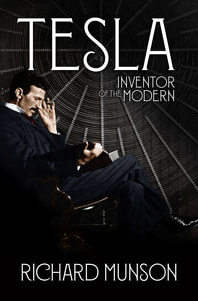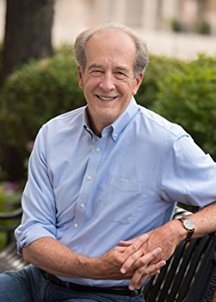"To harness the forces of nature to the service of mankind”: An interview with Richard Munson
Today on Gotham, Peter-Christian Aigner speaks with Richard Munson, director of the Environmental Defense Fund’s clean-energy efforts in the Midwest and the author of several books, about his new work, Tesla: Inventor of the Modern.
Ask ordinary people to name a famous inventor, and you'll hear 'Thomas Edison' more likely than not, although Nikola Tesla, you say, foresaw everything which defines our world technologically: cell phones, radar, laser weapons, artificial intelligence, the Internet, fax machines, vertical-life airplanes. You quote a person speaking before the nation's largest group of engineers, claiming by 1917 already that if not for him, "the wheels of industry would cease to turn, our electric cars and trains would stop, our towns would be dark, our mills would be dead and idle." So was he forgotten?
Tesla never was forgotten, but I argue he is underappreciated. Tesla won the War of the Currents and invented the electric motor and long-distance power transmission, but Edison is the more famous. The U.S. Supreme Court ruled Tesla’s patents were the first to describe radio transmissions, but Marconi is better known. In part that disconnect results from Edison developing products — such as the lightbulb and the phonograph — that consumers can touch and understand, while Tesla’s inventions — such as alternating current — serve as the foundation of our economy but are not readily apparent.
What prompted you to write about Tesla? And did you learn anything surprising in the process? What do we get right or wrong about him?
Like many people, I long knew a bit about Tesla, was fascinated, and wanted to learn more. What surprised me was that the scientist was more than, as one biographer put it, “a Supernova in the galaxy of the human race.” No doubt electric motors, robots, remote control, and radio are rather super accomplishments, but this inventor also was human, charmingly so. Although most happy when he worked alone in his laboratory, Tesla enjoyed friends and could be an engaging conversationalist. According to one journalist: “Tesla’s bright eyes glowed as he spoke of his work. He’s a talker from whose train of reasoning there was no escape while a man was under his influence.”
Edison's closest adviser invites him to New York City, but he doesn't have a good first impression. Why? And what makes him stay? Could Tesla have made it anywhere else?
A cultured European, Tesla arrived at Castle Clinton, the gloomy former fort that preceded Ellis Island, and found New York City in the 1880s to be cluttered and lacking in elegance, yet he quickly appreciated its economic opportunities. The metropolis presented a thriving mix of immigrants, entrepreneurs, and financiers, making it the hub of inventing.
What separates Edison and Tesla in the "War of the Currents"?
Ostensibly the war resulted from a technical disagreement over whether electricity should be transmitted via direct current or alternating current, but it also reflected different views about electricity’s future. Edison tended to think power would remain a luxury item enjoyed by those, such as J.P. Morgan, who could afford small generators in their homes. Tesla’s vision was more democratic, with centralized power plants sending electricity to far-flung communities, which could then only be done with alternating current (AC). The “war” became gruesome when Edison, trying to defend his investments in direct-current equipment, caused several animals to be electrocuted by high-voltage alternating current. In partnership with George Westinghouse, of course, Tesla demonstrated AC to be the superior technology.
What are Tesla’s major turning points in New York City?
Tesla arrived in Manhattan with only four cents in his pocket. He earned a decent wage from Thomas Edison, but left after the Wizard of Menlo Park failed to pay a promised bonus for Tesla tripling the output of a dynamo. Tesla started his own company, but his investors cheated him, and the inventor spent a year digging ditches, earning only $2 per day. When Tesla finally sold his electric motor patents to George Westinghouse, however, he moved into the Waldorf-Astoria and started eating meals at Delmonico’s. Towards the end of his life, when his major investment in the wireless transmission of power did not pan out, he declared bankruptcy and lived alone, often surrounded by pigeons, at the Hotel New Yorker.
Does the work continue? How is NYC different for a person in his field now?
Tesla offers an example of curiosity-seeking, idealistic inventing. Today’s innovations tend to be done by teams at federal labs, universities, or corporate research centers, and they usually are focused on profit. Even Edison developed new products in order to make money, while Tesla — although he certainly enjoyed his lavish meals at Delmonico’s and his fancy room at the Waldorf Astoria — believed that technology transcended the marketplace and that invention should not just be tied to profits. He wrote: “The desire that guides me in all I do is the desire to harness the forces of nature to the service of mankind.” In my opinion, NYC and other communities need to embrace Tesla’s example of selfless, out-of-the-box thinking if we are to tackle climate change, pervasive poverty, and other worldly challenges.
No doubt Tesla aimed high, perhaps higher than any other inventor. He worked tirelessly to offer electric power freely to the world and to build robots that would reduce life’s drudgery. He demonstrated that creation can be the most important thing in one’s life. And we are the better for it.

